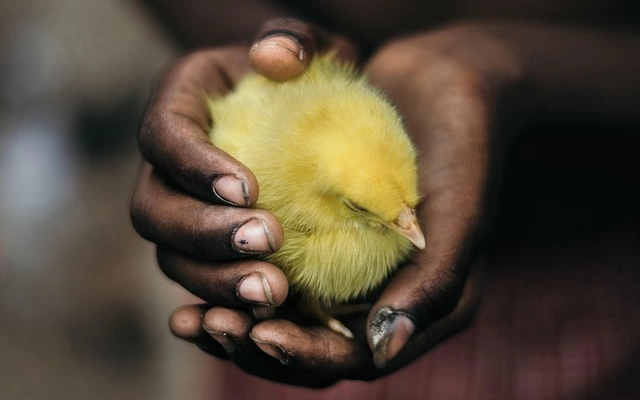This month, we are profiling the poultry breeds which are high yielding and easy and cheap to rear and could, therefore, make you a poultry farming millionaire in a very short time. In the first of the series, we profiled the Kuroiler breeds of chickens. In this post, we will profile the Rainbow Rooster birds.
The Rainbow Rooster is a multicolored bird that is highly disease resistant, fast growing and a dual purpose chicken which can also be grown in “kienyeji-like” circumstances. It is a good breed to choose if you want to carry out low cost free range or semi-free range farming with minimal input. It is also suitable for those who would want to carry out free range or organic farming. It is one of the most suitable breeds for farmers to grow in Kenya along with the Kuroiler and the KARI Improved Kienyeji chicken. It is highly suited for the rural rearing conditions and also very adaptable as a bird.

Indian Origins
Like the Kuroiler and the Indbro, this bird originated from India where it was bred by the Indbro Research Breeding Farms in India. The Rainbow Rooster lays more eggs and has low mortality rates, one of the factors which make it ideally suited for farmers in the rural areas. The Rainbow Rooster is very similar to Kenya’s indigenous chicken with the only difference being that they grow very fast and lay more eggs. They are also bigger than the ordinary Kienyeji birds.
Background Information About the Rainbow Rooster Birds
The birds can be reared both on a backyard subsistence level as well as a commercial breed due to the fact that it lays more eggs, grows faster and produces very good quality meat. It is especially advantageous because the process of rearing the Rainbow Roosters is not as capital-intensive as the process of rearing the layers and broilers. This is one of the reasons why the Rainbow Rooster rearing can easily be carried out by the small scale farmers in many parts of Kenya who may not have much money to start with.
Rainbow Roosters have several characteristics that make them ideal candidates for rearing in the rural areas and in most areas in Kenya. They are highly adaptable birds and offer great performance and adaptability to farmers in most areas in Kenya. Compared to the indigenous Kienyeji birds, they offer higher egg productivity. They were originally developed by the Indbro Research Pvt in India.
They are best reared in the free range as well as the semi-free range conditions and they are also perfect for use as dual purpose birds. Farmers can rear them for both egg production and meat production. The bird is also multi-colored. This is where it derives its name “Rainbow Rooster”. They Rainbow Rooster was developed through the interbreeding of fast growing broilers and high laying brown birds which are resistant to diseases.
Rainbow Roosters are Perfect for Brooding
Brooding is one of the areas that most farmers fear the most due to the challenges involved. The Rainbow Roosters have a very fast growth potential, particularly in their first six weeks. That means farmers will grapple with less brooding issues.
Rainbow Roosters are Tasty
They also have less fat and more meat and are, therefore very tasty chicken. The Rainbow Roosters have all the attributes that you would find in the indigenous birds with difference that they mature much faster and produce more eggs. Unlike broilers, they also have less fat and produce meat that is more tasty. It tastes just like the Kienyeji birds.
Rainbow Roosters can be kept in various systems. These include the following:-
- On Broiler Feeds
- As scavenging birds in free range of semi-free range system
- On layer chick formula under a semi-intensive system
Housing Rainbow Roosters
Housing Rainbow Roosters is a very simple. Refer to our Kienyeji Housing Manual for information on how to house these chickens.
Scavenging Rainbow Roosters
When kept in the scavenging systems, the male Rainbow Rooster birds will be able to attain a 1.3Kg live weight within the first 10 weeks. The females will be weighing 1.1Kg at about the same age. Just like the indigenous Kienyeji chicken, the Rainbow Roosters can also be kept in the free range mode. You will, however, get optimal performance only when you keep them in the semi-intensive or semi-free range system. This involves concocting locally sourced materials such as omena, vegetables, kitchen wastes and combining these with the products of scavenging such as worms, grit and greens along with the balanced poultry feeds that you will buy from the Agrovet.
You could also formulate your own poultry feeds in your backyard. Refer to our Rainbow Roosters poultry formulation manual for additional information and guide on how to make your own Rainbow Roosters feed or how to formulate kienyeji feeds at home.
Rainbow Roosters Egg Production
Under good management, the Rainbow Roosters will produce 180-200 eggs per year. Compare to the 40-60 eggs per year for the ordinary kienyeji, you can see the great advantage of the Rainbow Roosters. On the other hand, the Improved Kienyeji Breeds still produce more eggs than the Rainbow Rooster chickens.
Brooding
It is important to note that the Rainbow Roosters birds do not engage in brooding. This is a characteristic which was intentionally developed during breed development in order to boost the egg production. If you want to get more chicks, you can either buy new Rainbow Rooster chicks or invest in an egg incubator or hatchery. The best place to buy reliable Rainbow Rooster parent stock in Kenya is Kukuchic in Eldoret.
Rainbow Rooster Taste
The meat from the Rainbow Rooster birds is very tender and tasty. The birds are multicolored as discussed above and these are generally highly preferred in the market by consumers looking for non-broiler meat. Because of their great adaptability, they can be reared almost anywhere in Kenya.